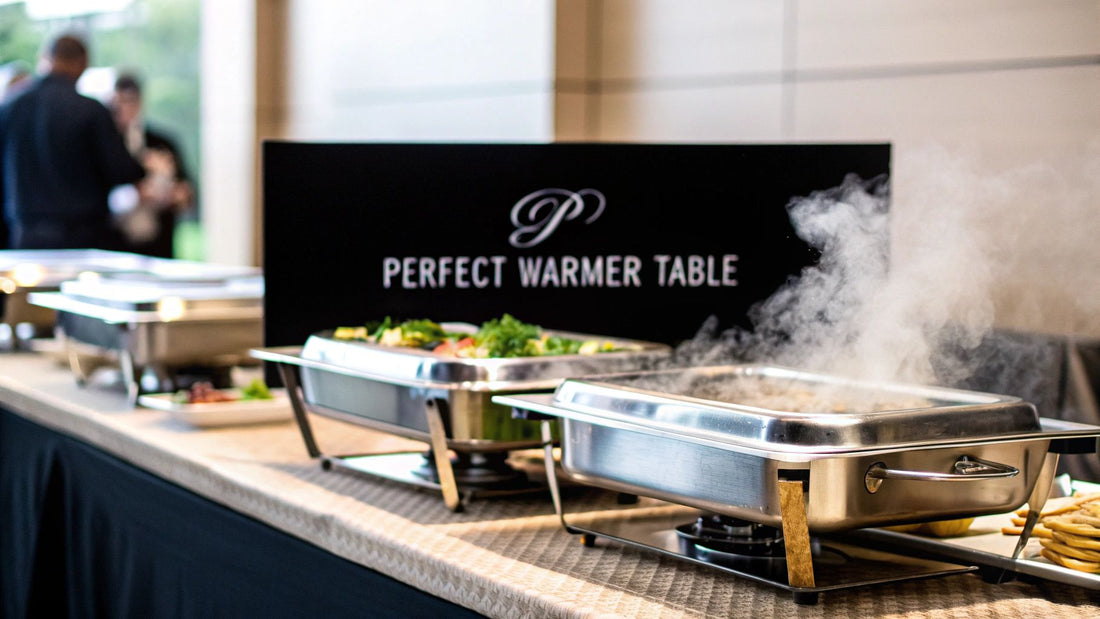
Choosing Your Perfect Food Warmer Table
Share
Let’s be honest, in a busy kitchen, the journey from the stove to the customer's table is a minefield. That perfect dish you just plated can lose its magic in minutes, turning from a hot, delicious meal into a lukewarm disappointment. This is where a food warmer table becomes one of the most valuable players on your team.
Think of it as your quality control station. It's not just a piece of heated metal; it’s the bridge that ensures the food you worked so hard on stays at the perfect temperature, texture, and flavor right up until it's served. For restaurant owners and chefs looking to stay ahead, understanding industry trends and finding exclusive deals on essential equipment like this is key to success.
The Secret to Perfect Serving Temperatures
For any high-volume operation—whether you're running a buffet, catering a huge event, or managing the lunch rush at a fast-casual spot—a food warmer table is indispensable. It's the silent partner that makes sure the last plate served is just as incredible as the first.
Without one, you're constantly fighting the clock. You risk serving inconsistent food, or worse, throwing out perfectly good dishes that have cooled down too much. It’s a battle that costs you money and can damage your reputation. Stay informed about the latest equipment and supplies to avoid these common pitfalls.
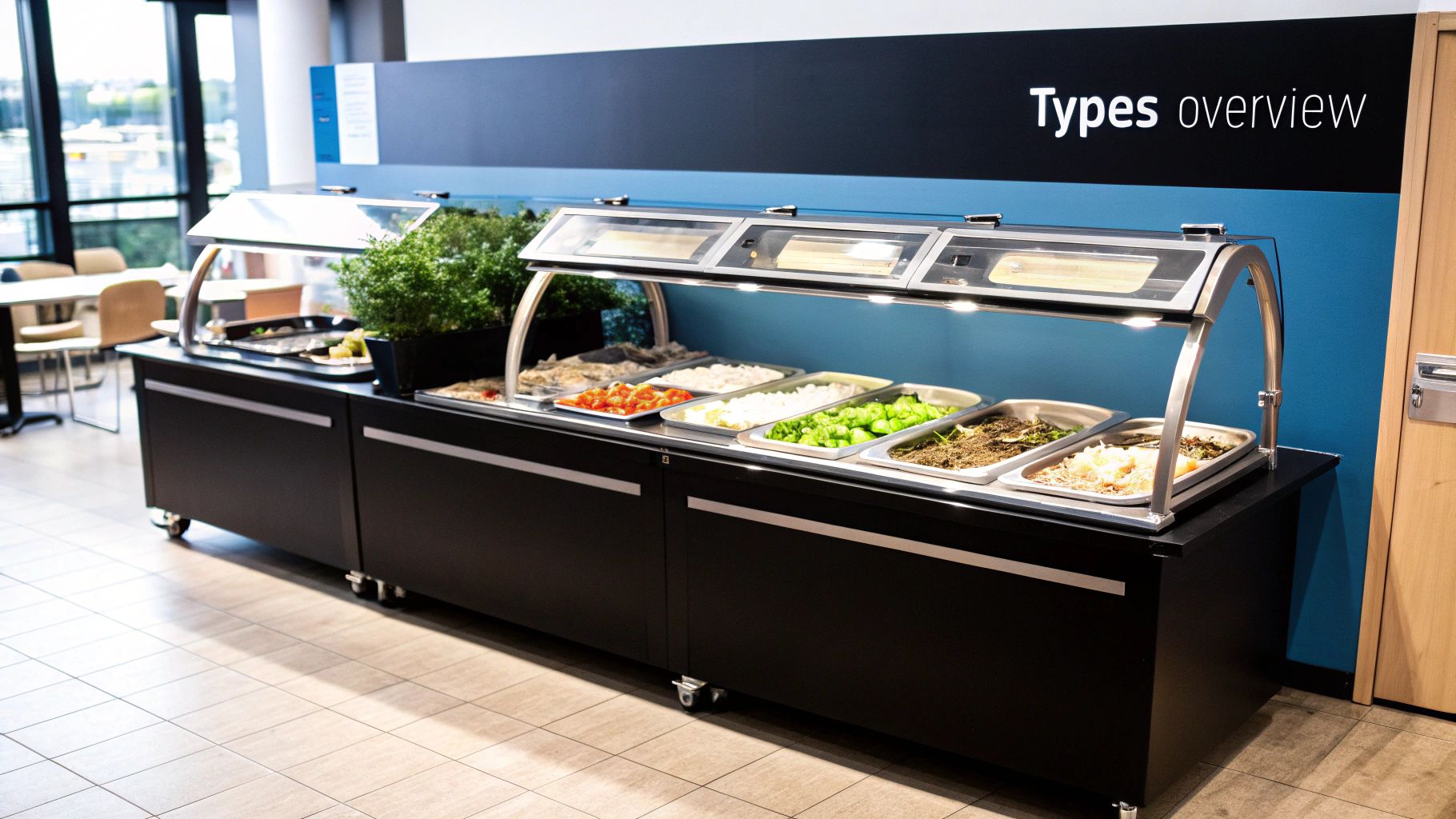
Why Mastering Food Holding Is Critical
Getting food holding right is about so much more than just keeping things warm. It’s a fundamental part of running a successful and safe kitchen. A good food warmer table protects your business from multiple angles.
- Passing Health Inspections: Health codes are non-negotiable. Food has to be held above 140°F (60°C) to stop harmful bacteria from growing. A reliable warmer isn't just a good idea; it's a requirement to keep your customers safe and the health inspector happy.
- Slashing Food Waste: Every time a dish drops below that safe temperature, it's headed for the trash. That's money you're literally throwing away. By extending the life of your batch-cooked items, a warmer directly pads your bottom line.
- Building Customer Trust: Nothing says "we care" like a consistently hot meal. When customers know they can count on you for quality every single time, they come back. It’s that simple.
A food warmer table is more than just a piece of equipment; it's an investment in your restaurant's reputation. It ensures that the quality crafted in the kitchen is the same quality experienced by your customers at the table.
At the end of the day, this tool solves a massive logistical headache. It empowers your kitchen staff to cook ahead of a rush without ever compromising on the final product. For any chef who takes pride in their food or any owner watching their profits, a food warmer table isn't a luxury—it's essential.
How Food Warmers Actually Keep Food Fresh
It’s easy to think of a food warmer table as just a hot box, but that’s selling it short. These are actually precision tools, engineered to do much more than just "keep food hot." They’re designed to fight a constant battle against heat loss, moisture evaporation, and bacterial growth, creating a stable environment that protects the quality your chefs just spent hours creating.
At their heart, all food warmers use heating elements—usually electric coils or gas burners—to generate a steady, controlled warmth. That heat is then transferred to the food pans sitting in the unit’s wells or on its surface. But how that heat gets from the element to the food is what really matters. This difference creates two distinct types of warmers, each with its own specialty.
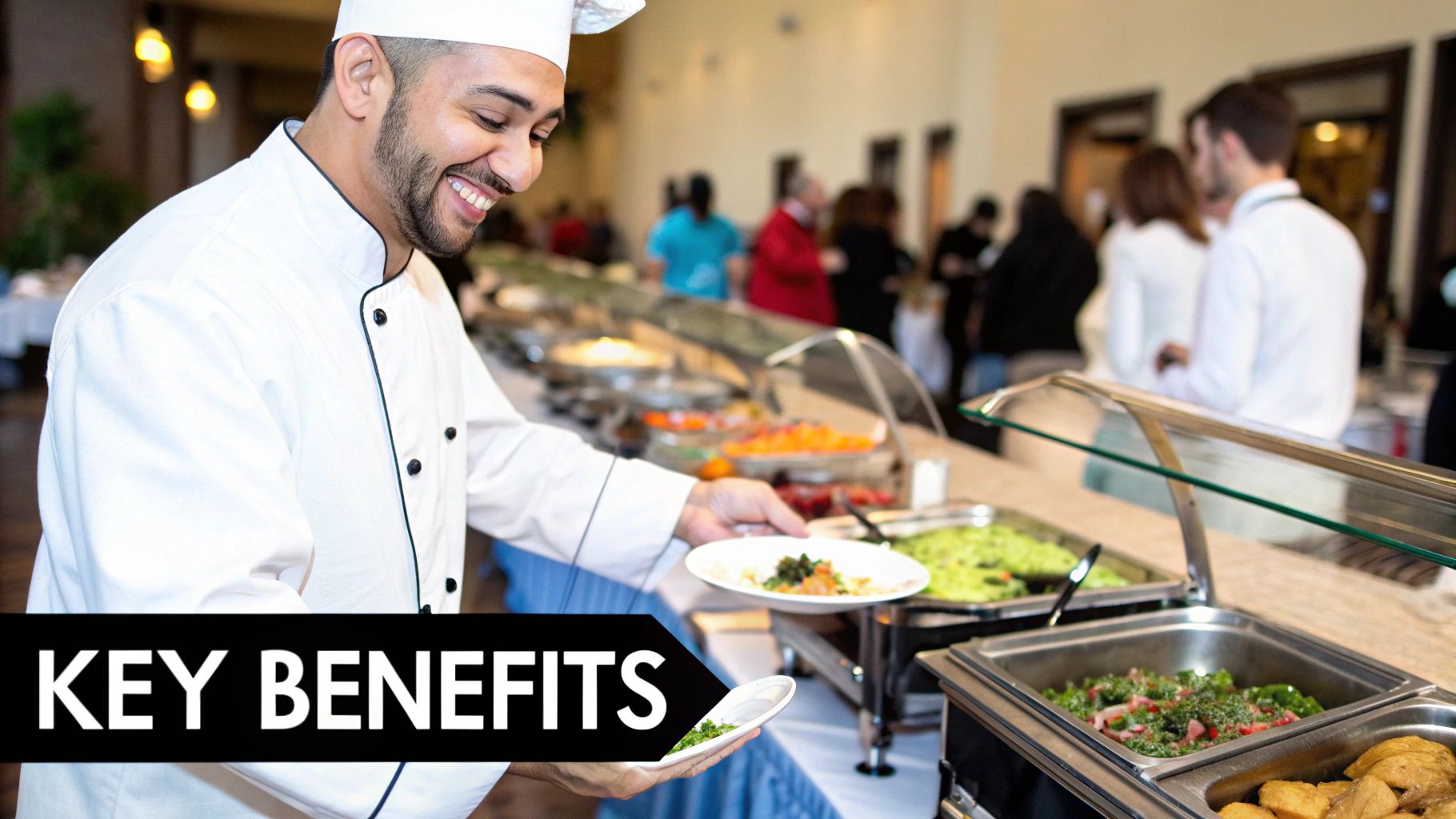
Let's break down how each type works so you can match the right warmer to your menu.
Dry Heat: The Secret to Crispy Preservation
A dry heat food warmer basically works like a very low-temperature oven. The heating elements are enclosed, and they warm up the air inside the unit. This hot air then circulates around the food pans, keeping everything at the right temperature. This method is the go-to choice for any food that needs to stay crispy or crunchy.
Think about it: what happens to fried chicken if it sits in a steamy, humid environment? That perfect, crispy coating turns into a soggy, sad mess. Dry heat is the solution. It creates a low-humidity environment that pulls excess moisture away from the food, preserving its texture.
Dry heat warmers are the unsung heroes for items like:
- Fried Foods: French fries, onion rings, and fried chicken stay perfectly crisp.
- Roasted Items: Things like roasted potatoes and vegetables keep their nicely browned exteriors.
- Baked Goods: Dinner rolls, breadsticks, and biscuits stay warm without getting damp.
The whole point is to avoid condensation, which is the mortal enemy of anything crunchy. If you want to maintain that satisfying crunch, a dry heat warmer is what you need.
Wet Heat: The Gentle Sauna for Your Food
On the flip side, you have wet heat food warmers, which everyone in the industry just calls steam tables. These units take the complete opposite approach. Think of them as a gentle sauna for your food, designed specifically to lock in moisture and stop delicate dishes from drying out during a long service.
Steam tables have a water pan (or well) underneath where the food pans sit. A heating element, often an immersion coil, heats that water until it produces a consistent cloud of steam. This steam gently surrounds the food pans, transferring heat evenly and creating a humid atmosphere that is absolutely essential for certain types of food.
A steam table doesn’t just keep food warm; it actively preserves moisture. This gentle, humid heat is the key to holding items like mashed potatoes, gravies, and steamed vegetables at their peak texture and consistency for hours.
Imagine trying to hold a pan of mac and cheese or a rich beef stew on a dry warmer. The top would form a dry, unappetizing skin in no time. A steam table prevents that entirely, making it the perfect choice for:
- Sauces and Gravies: They won't reduce down or form a skin on top.
- Mashed Potatoes and Pasta: They stay creamy and moist instead of getting dry and clumpy.
- Steamed Vegetables: Their color, texture, and moisture are perfectly maintained.
- Soups and Stews: You can keep them at a consistent, servable temperature without any risk of scorching the bottom.
Once you get a handle on these two heating methods, you can start strategically matching the right food warmer to your menu, ensuring every single dish is held in the perfect environment.
Finding the Right Type of Food Warmer Table
Picking a food warmer table isn't a one-size-fits-all deal. The right piece of equipment should feel like a natural part of your kitchen's flow, but the wrong one can quickly become a bottleneck, causing service headaches you just don't need. Think of it like a chef's knife collection—you wouldn’t use a delicate paring knife to butcher a primal cut, right? The same logic applies here.
The market is full of options, each built for a specific purpose. You've got massive, stationary units designed for high-volume buffets, and then you have compact, portable warmers perfect for a catering gig across town. Your final choice really boils down to your menu, how you serve your customers, and the space you're working with. Getting this right means you’re investing in a tool that truly helps your operation, not one that gets in the way.
Stationary Buffet Tables
For any place running a busy, consistent serving line—we're talking hotel buffets, large cafeterias, or big event venues—the stationary buffet table is the undisputed workhorse. These are big, sturdy units built to stay put and hold a serious number of full-size food pans for hours on end.
They’re usually made from heavy-duty stainless steel and are hardwired straight into your building's electrical system for steady, reliable power. Their biggest selling point is capacity and stability. You can serve hundreds of people with confidence, knowing every dish is held at a safe and appetizing temperature. The trade-off, of course, is that they have zero mobility, which makes them a poor fit for any business that needs to be flexible.
Portable Warmers for Catering
If your business is always on the move, a portable food warmer is an absolute must-have. Built for caterers, food trucks, and pop-up events, these units pack the heating power of a stationary model into a more compact design with wheels. They're built tough to handle being loaded in and out of vans.
Portability is the name of the game here, letting you bring a high-quality, hot food experience to any location. Just keep in mind they typically hold less food than their stationary cousins. You’ll also need to plan ahead and make sure you'll have access to the right power outlets at the event site—that's a rookie mistake you don't want to make.
Compact Countertop Units
What if you're tight on floor space but still need to keep things warm? That's where countertop food warmers come in. These little guys are perfect for squeezing onto a crowded kitchen line, a concession stand, or into a small cafe. They're ideal for holding just a few key items, like a signature soup, chili, or that crowd-pleasing nacho cheese.
Their tiny footprint is their best feature, allowing pretty much any kitchen to add holding capacity without a major remodel. The obvious downside is their limited volume. Think of a countertop unit as a specialist for specific menu items, not the answer for a full-blown buffet.
Custom Drop-In Models
For that truly seamless, high-end look, custom drop-in models are the top-tier option. These units are designed to be installed directly into a custom-built countertop or serving station, creating a clean, integrated aesthetic. You'll often see them in upscale hotel buffets and designer kitchens where looks matter just as much as performance.
The biggest pros are the polished appearance and a perfect fit for your space. However, that custom look comes with a higher price tag and requires professional installation, making it a more permanent and less flexible choice than a standalone unit.
To help you sort through these options, let’s compare them side-by-side. This table breaks down the key features of each type to make your decision a bit easier.
Comparing Food Warmer Table Models
| Warmer Type | Heating Method | Best For | Pros | Cons |
|---|---|---|---|---|
| Stationary Buffet | Electric (Wet or Dry Heat) | High-volume buffets, cafeterias, event halls | High capacity, stable, consistent heating | Not portable, requires dedicated space |
| Portable Catering | Electric or Canned Fuel | Off-site catering, food trucks, pop-up events | Mobile, flexible, durable for transport | Smaller capacity, potential power supply issues |
| Countertop | Electric (Typically Wet Heat) | Small kitchens, concession stands, specific items | Space-saving, great for individual dishes | Very limited capacity, not for full meal service |
| Custom Drop-In | Electric (Wet or Dry Heat) | Upscale restaurants, hotels, designer installations | Seamless look, custom fit, professional grade | Expensive, requires professional installation, permanent |
Ultimately, the best model is the one that fits your specific workflow, menu, and budget. Whether it's a large stationary unit for your daily brunch rush or a nimble countertop warmer for your famous chili, matching the tool to the task is key.
Demand for this kind of equipment is clearly on the rise. Keeping an eye on industry trends is crucial for savvy restaurant owners. The global market for food warmer machines was valued at USD 2.67 billion in 2024 and is expected to climb to USD 4.46 billion by 2032, largely because more people want convenient, hot takeout and delivery. You can read the full research on food warmer machines to get a deeper look at this trend.
Choosing the right type of warmer table is a strategic decision that directly impacts service efficiency and food quality. Match the equipment to your specific operational needs—buffet, catering, or kitchen line—to maximize your return on investment.
This image gives you a quick visual comparison of how different models stack up on key metrics like energy consumption and heat retention.
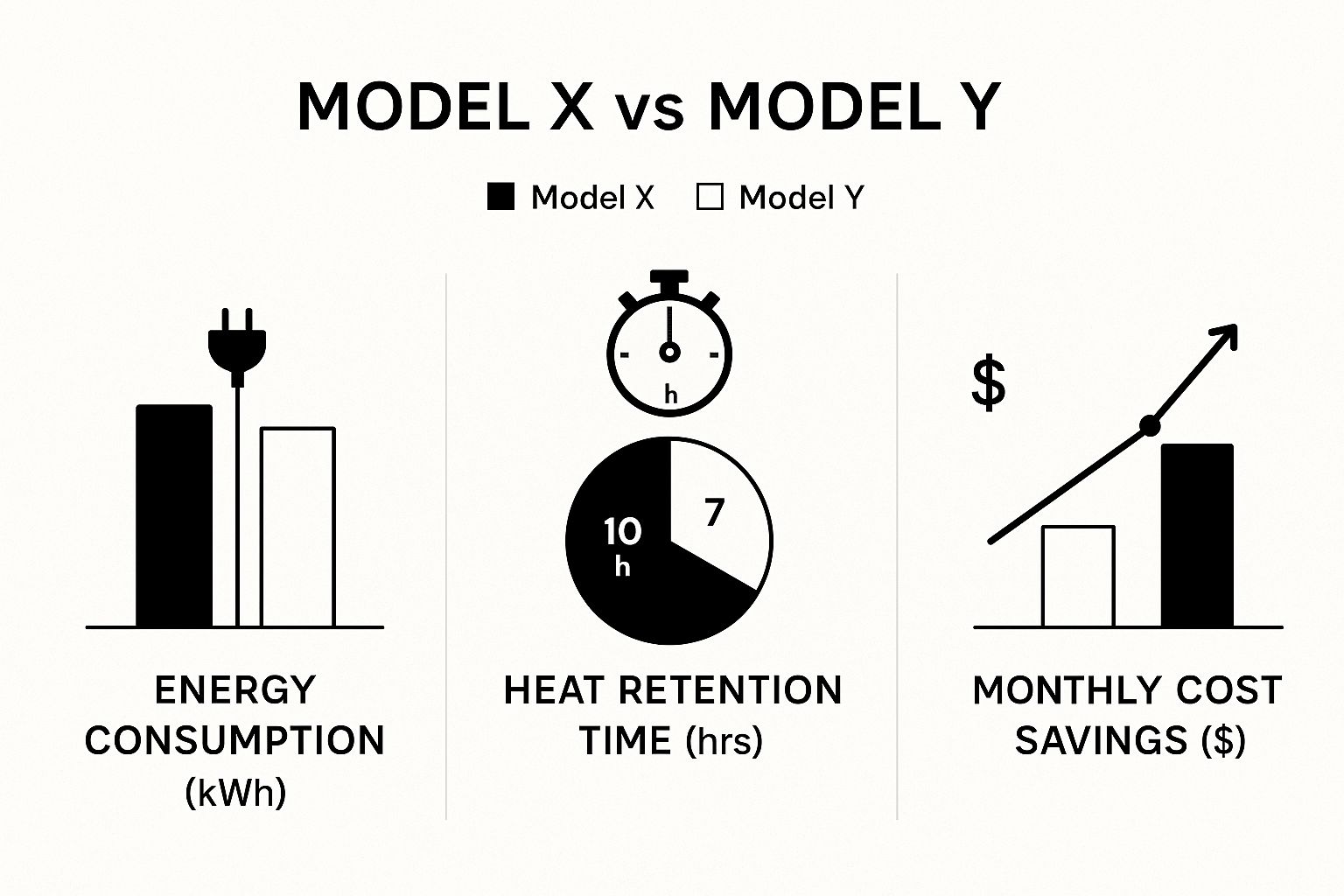
As you can see, opting for a more energy-efficient model might cost a bit more upfront, but it can lead to real savings on your utility bills each month while keeping your food hotter for longer. For more detailed advice, you can also check out our guide on food warmers for your table.
Key Factors for Selecting Your Food Warmer
Choosing the right food warmer table is one of those decisions that can quietly make or break your service efficiency. It’s not just about finding something in your budget; it’s a strategic move that affects food quality, kitchen workflow, and even your monthly utility bills. Get it right the first time, and you’ll save yourself a world of headaches and costly mistakes down the line.
Think of it like this: you wouldn't buy a delivery van without checking its cargo space, fuel efficiency, and reliability. We need to apply that same level of scrutiny here. By walking through a few crucial factors, you can pick a unit that feels like it was custom-built for your menu, your team, and your space.
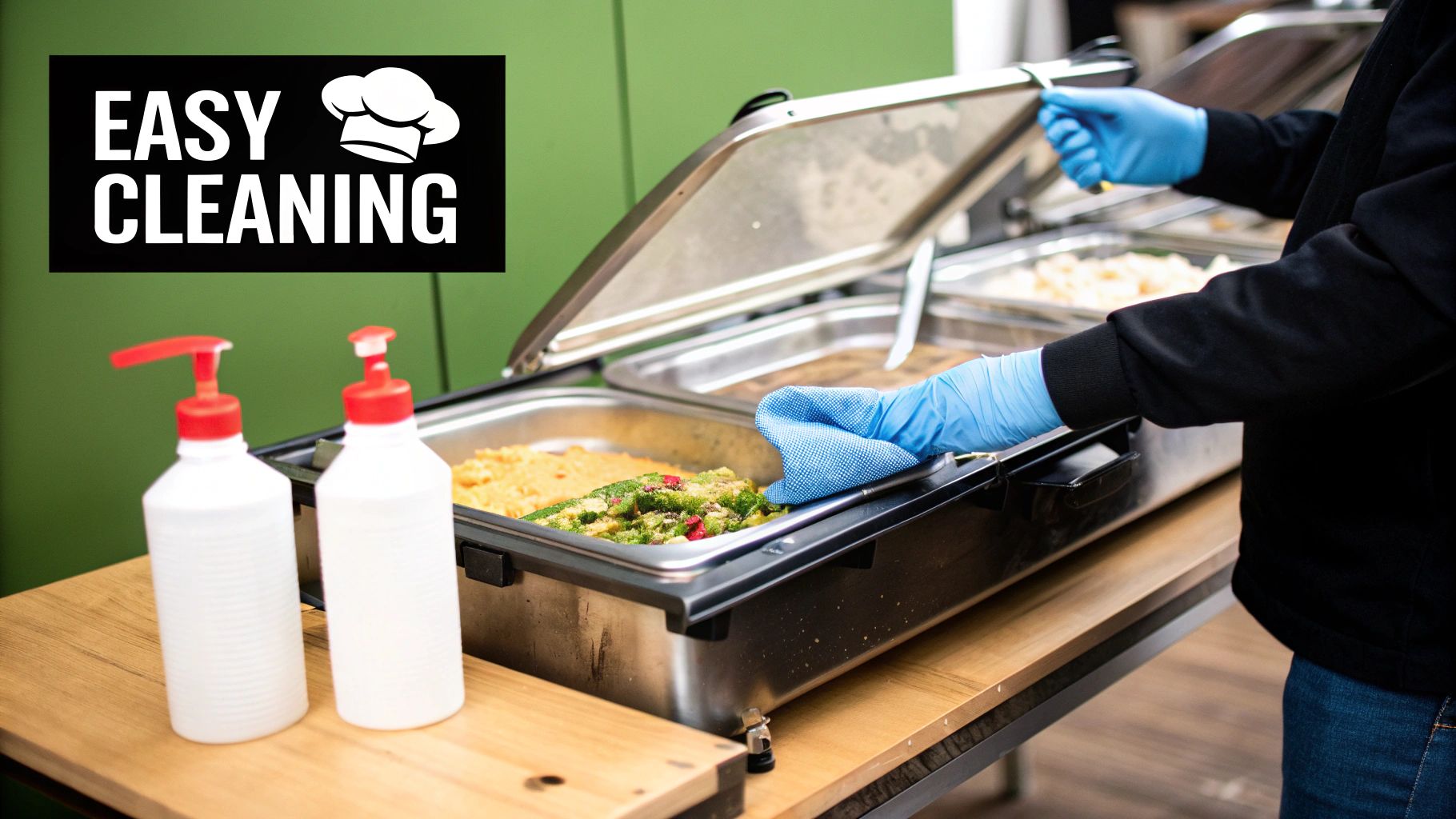
Capacity and Physical Footprint
First things first: size. How many food pans do you actually need to hold when you're in the weeds on a Saturday night? Underestimate, and you've created a massive bottleneck. Overestimate, and you're just paying to heat air. Take a hard look at your peak service volume and pick a model that can handle it with a little room to spare.
Just as important is the unit's actual footprint. Kitchen space is some of the most expensive real estate you'll ever manage. Before you even open a browser tab, grab a tape measure. Figure out exactly where this table is going to live, measuring the length, width, and height you have to work with. Don't forget to leave enough clearance for proper ventilation and for your staff to move around without bumping into it.
Power Source and Energy Efficiency
Next up is the electric versus gas debate. Each has its place, and the right choice often comes down to your kitchen’s existing infrastructure and what you pay for utilities.
- Electric Models: These are the go-to for most kitchens. They offer incredibly precise temperature control and installation is a breeze—just plug it in. They’re also generally seen as safer for indoor use and deliver very consistent, even heat.
- Gas Models: If you need to get up to temperature fast, gas is your friend. It can also be cheaper to run in areas where natural gas costs less than electricity. The trade-off? You'll need a professional for installation and proper ventilation is a must.
Whatever you choose, keep an eye out for an ENERGY STAR certification. These models might cost a bit more upfront, but their efficiency pays you back over time with lower energy bills, directly boosting your bottom line. Look for exclusive deals on these models to maximize your investment.
Material Durability and Construction
A food warmer's material determines its lifespan and how much of a headache it is to clean. The undisputed champion here is stainless steel, and for good reason. But not all stainless steel is created equal. You’ll want to look at the grade—304 stainless steel is the premium, corrosion-resistant choice that’s perfect for food contact surfaces, while 430 grade is a common and perfectly fine option for exterior panels.
A well-built food warmer table made from high-grade stainless steel is not just an appliance; it's a long-term asset. It withstands the daily abuse of a commercial kitchen, resists rust, and makes sanitation simpler, protecting both your investment and your customers.
Give the unit a good once-over. Are the legs sturdy? Are the seams fully welded? Welded joints are far more sanitary than joints that are just screwed together. If a unit feels flimsy in the showroom, it won't stand a chance in a real working kitchen.
Temperature Controls and Safety Certifications
How you control the heat is a game-changer. You'll typically find two types of controls: thermostatic and infinite.
- Thermostatic Controls: These let you dial in a specific temperature—say, 160°F—and the unit automatically cycles on and off to hold it there. That kind of precision is vital for keeping delicate sauces or proteins in the perfect state and is key for food safety.
- Infinite Controls: These are simpler, with a basic low-to-high dial and no specific temperature markings. They are less precise but work just fine for hearty items like chili or baked beans where a few degrees either way won't ruin the dish.
Finally, for any piece of equipment in a commercial kitchen, NSF certification is non-negotiable. This little mark is your guarantee that the warmer has been rigorously tested to meet public health and safety standards. An NSF-certified unit is built for safe, sanitary operation and is your ticket to passing your next health inspection without a second thought.
The need for high-quality holding equipment is only growing, especially with the boom in catering and food delivery. Keeping informed about the latest news on restaurant equipment supplies can give you a competitive edge. This growth is fueled by better tech in temperature control and automation.
Mastering Daily Use and Maintenance
Getting the right food warmer table is a great start, but its real value comes from how you use and care for it every single day. Don't just think of it as another appliance; it's a critical part of your food safety and quality control. Nailing its operation means every plate you serve is safe, delicious, and meets your standards—all while protecting your investment for the long haul.
Proper use starts well before service even begins. Preheating is non-negotiable. Fire up your unit a good 20-30 minutes before you need it. This gives it time to reach a stable, safe holding temperature so you don't get a dangerous temp drop when you add your hot food. If you're using a wet heat model, fill the wells with hot water from the start. It’ll heat up much faster and save you on energy costs.
Daily Operational Best Practices
Once your warmer is up to temp and ready to go, a consistent routine is what separates good food from great food. This isn't just about keeping things hot; it’s about holding onto the texture, moisture, and flavor that your chefs worked so hard to create.
A few simple habits can make a world of difference:
- Use Lids Consistently: Keep those food pans covered whenever you're not serving from them. Lids trap heat and moisture, which stops food from drying out and helps the unit run more efficiently.
- Stir Food Periodically: For things like sauces, stews, or mac and cheese, give them a gentle stir every 15-20 minutes. This keeps the heat distributed evenly and stops that unappealing skin from forming on top.
- Avoid Overloading Pans: It’s tempting to fill pans to the brim, but that often leads to uneven heating. The food in the middle will struggle to stay hot. It’s much better to work in smaller batches and refill as needed.
The golden rule? Stay out of the "temperature danger zone." All hot food must be held at or above 140°F (60°C). No exceptions. Use a calibrated food thermometer to spot-check the internal temperature in each well throughout service.
This isn’t just a friendly suggestion—it’s a critical food safety mandate that protects both your customers and your reputation.
Creating a Bulletproof Cleaning Schedule
A clean food warmer doesn't just look better; it runs more efficiently and is essential for preventing bacterial growth. A daily cleaning routine is your absolute first line of defense. At the end of every shift, shut the unit down, unplug it, and let it cool completely before anyone touches it with a cleaning cloth.
Here’s a simple, effective daily cleaning process:
- Drain and Remove: For wet heat models, carefully drain all the water. Pull out all the food pans, lids, and any other inserts.
- Wash Removable Parts: Get all those pans and inserts into your three-compartment sink for a proper wash, rinse, and sanitize cycle.
- Clean the Interior and Exterior: Wipe down every surface, inside and out, with a soft cloth, warm water, and a mild, food-safe detergent. Really get into the corners and crevices where gunk loves to hide.
- Sanitize and Air Dry: After cleaning, wipe all surfaces with a food-safe sanitizer. Let everything air dry completely before you put it back together.
Beyond the daily wipe-down, you'll want to do a deeper clean weekly. This is key for tackling things like mineral buildup in steam tables, which can wreak havoc on heating elements over time. And don’t forget that keeping your equipment clean is just one part of a bigger picture that includes solid restaurant pest control to ensure total food safety.
Troubleshooting Common Issues
Even the best-maintained equipment has its off days. Knowing how to spot and fix common issues can save a busy service from grinding to a halt.
If you’re noticing cold spots, the first thing to check on a steam table is the water level—it's often the culprit. If the thermostat seems to be acting up, make sure the unit is plugged into a dedicated circuit so it's not fighting for power. For anything more complicated, our guide on commercial kitchen equipment maintenance has more detailed solutions.
Staying current with industry trends shows that smart, connected food warmers are on the horizon, promising even better efficiency and diagnostics. Mastering the maintenance of your current assets is fundamental to your kitchen’s long-term success and readiness for future innovations.
Your Top Food Warmer Questions, Answered
Even after you get the hang of your food warmer table, some practical questions always pop up in the heat of service. I get calls about these all the time from chefs and new restaurant owners. Think of this as your go-to cheat sheet for handling those day-to-day uncertainties like a seasoned pro.
Getting straight answers to these common queries helps your team keep food quality high, stay on the right side of the health inspector, and really get the most value out of this kitchen workhorse.
Can You Use a Food Warmer Table to Cook Food?
Let's clear this one up right away: absolutely not. This is probably the most critical thing to understand about this piece of equipment. A food warmer table is a holding device, period. Its only job is to keep food that is already properly cooked at a safe temperature.
The heating elements just aren't powerful enough for actual cooking. They're designed to maintain heat, not to blast raw chicken or ground beef with the high temperatures needed to make them safe to eat. Trying to cook in a food warmer is a shortcut to the danger zone, creating a serious risk of foodborne illnesses like Salmonella or E. coli.
Rule of thumb: Cook it first, then hold it. Always bring food to its correct internal temperature on a grill, stovetop, or in an oven before it ever sees the inside of your preheated food warmer.
What Is the Difference Between a Steam Table and a Dry Warmer?
This all comes down to how the unit heats your food, and it makes a huge difference in the final product you serve your customers. Choosing the wrong one for your menu can ruin the texture of a dish.
A steam table (or wet heat warmer) is exactly what it sounds like. It has a well you fill with water, which creates a gentle, hot steam that envelops the food pans. This humid environment is perfect for anything you want to keep moist and juicy.
- Think mashed potatoes, pasta dishes, or steamed veggies.
- It's a lifesaver for anything with a sauce or gravy, preventing that unappetizing skin from forming.
- Soups and stews also hold beautifully without scorching or reducing down.
On the flip side, a dry warmer works more like a low-and-slow oven, using heating elements to warm the air around the pans. This dry heat is your best friend for anything you want to stay crispy.
- It’s the only way to go for fried foods like french fries, onion rings, or fried chicken.
- It keeps roasted items from getting soggy.
- Things like dinner rolls or garlic bread stay warm without turning into a steamy mess.
How Often Does a Food Warmer Table Need to Be Cleaned?
Every. Single. Day. This is non-negotiable. At the end of each service, the unit has to be shut down, cooled off, and cleaned thoroughly. Leftover food spills and murky, stagnant water are a playground for bacteria. Skipping this chore is asking for health code violations and putting your customers at risk.
Your daily cleaning routine should always include:
- Draining any water out of steam table models.
- Removing all food pans and inserts to be washed and sanitized separately.
- Wiping down every surface—inside and out—with a food-safe cleaner.
- Sanitizing any surface that touches food and letting it air dry completely.
On top of that, schedule a deeper clean at least once a week. For steam tables, this is when you’ll want to descale the water wells to get rid of mineral buildup. That gunk can wreck your heating elements and make the whole unit run less efficiently.
What Is the Most Important Safety Tip for Food Warmers?
If you remember one thing, make it this: temperature control. The whole point of a food warmer is to keep hot food safely out of the "temperature danger zone," which is anywhere between 40°F and 140°F (5°C and 60°C). Bacteria thrive and multiply like crazy in that range.
To keep your food safe, drill these habits into your team:
- Always preheat the unit. Give it a good 20-30 minutes to get up to temp before you even think about putting food in it.
- Use a calibrated food thermometer. Don't just trust the dial. Spot-check the actual internal temperature of the food in each pan regularly to make sure it’s holding at or above 140°F (60°C).
- Lids are your friend. Keep the food pans covered as much as possible to hold that precious heat in.
- Give things a stir. For soups, sauces, and stews, an occasional stir ensures the heat is distributed evenly and there are no cold spots.
And don't forget basic physical safety! Make sure the table is on a level, stable surface. It sounds obvious, but you'd be surprised. And always be careful around the hot surfaces and steam to avoid burns.
Equip your kitchen with the best and keep your service running smoothly. At Encore Seattle Restaurant Equipment, we offer a wide range of new and used food warmer tables to fit any operation and budget. Discover the latest industry news and exclusive deals on restaurant equipment to find the perfect solution for your needs.
Visit us online to browse our selection of food warmers.
